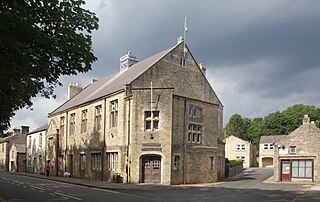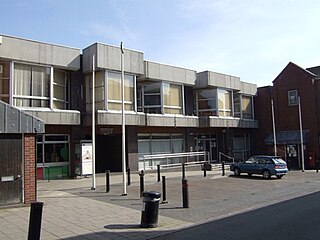
Hucknall, formerly Hucknall Torkard, is a market town in the Ashfield district of Nottinghamshire, England. It lies 7 miles (11 km) north of Nottingham, 7 miles (11 km) southeast of Kirkby-in-Ashfield, 9 miles (14 km) from Mansfield and 10 miles (16 km) south of Sutton-in-Ashfield. It is the second-largest town in the Ashfield district after Sutton-in-Ashfield.

Sutton-in-Ashfield is a market town in Nottinghamshire, England, with a population of 36,404 in 2021. It is the largest town in the district of Ashfield, four miles west of Mansfield, 2 miles (3 km) from the Derbyshire border and 12 miles (19 km) north of Nottingham.

Kirkby-in-Ashfield is a market town in the Ashfield District of Nottinghamshire, England. With a population of 25,265, it is a part of the wider Mansfield Urban Area. The Head Offices of Ashfield District Council are located on Urban Road in the town centre.

Mansfield is a market town and the administrative centre of the Mansfield District in Nottinghamshire, England. It is the largest town in the wider Mansfield Urban Area and the second largest settlement in Nottinghamshire. It gained the royal charter of a market town in 1227. The town lies in the Maun Valley, 12 miles (19 km) north of Nottingham. It had a population of 110,500 at the 2021 census. Mansfield is the one local authority in Nottinghamshire with a publicly elected mayor, the Mayor of Mansfield.

The Old Town Hall is a municipal building in the High Street in Needham Market, Suffolk, England. The building, which now accommodates an antiques centre and other shops, is a Grade II listed building.

Leconfield Hall, formerly Petworth Town Hall, is a municipal building in the Market Square in Petworth, West Sussex, England. The building, which is now used as a cinema, is a Grade II* listed building.

Beaumaris Town Hall is a municipal building on Castle Street, in Beaumaris, Anglesey, Wales. The structure, which is the meeting place of Beaumaris Town Council, is a Grade II listed building.

Crickhowell Market Hall, formerly Crickhowell Town Hall, is a municipal building in the High Street, Crickhowell, Powys, Wales. The structure, which accommodates market stalls on the ground floor and a café on the first floor, is a Grade II* listed building.

Invergordon Town Hall is a municipal building in the High Street in Invergordon in the Highland area of Scotland. The structure, which is used as a community events venue, is a Category B listed building.

The Moot Hall is a former municipal building situated on one corner of the Market Place in Mansfield, Nottinghamshire, England. The Grade II listed building now operates as shops at ground floor level.

The Corn Hall is a commercial building in the Market Place, Swaffham, Norfolk, England. The structure, which is used as offices and as a coffee house, is a Grade II listed building.

The Old Town Hall is a municipal building in St Mary Street, Newport, Shropshire, England. The structure, which is now divided into a series of shop units on the ground floor and used as a children's play area on the first floor, is a Grade II listed building.

Alresford Community Centre, formerly Alresford Town Hall, is a municipal building in West Street, New Alresford, Hampshire, England. The structure, which is now used as a community events venue, is a Grade II listed building.

The Arch Building, previously known as Cobh Town Hall and before that as Queenstown Town Hall, is a municipal building in Casement Square, Cobh, County Cork, Ireland. The building currently accommodates a public library and a tourist information centre. It is included in Cork County Council's Record of Protected Structures.

The Old Town Hall is a former municipal building in Bulwell, a town in Nottinghamshire, in England. The building, which is currently used as a furniture showroom on the ground floor and as a concert hall on the first floor, is locally listed.

Swadlincote Town Hall is a municipal building in The Delph in Swadlincote, a town in Derbyshire in England. The building, which serves a community events venue, is a Grade II listed building.

Stanhope Town Hall is a former municipal building on Front Street, Stanhope, a town in County Durham, England. The building is not currently in use and is being marketed for sale.

Ulverston Town Hall is a former municipal building on Queen Street, Ulverston, a town in Cumbria, England. The building has been converted for residential use.

Whitchurch Civic Centre is a municipal building in Whitchurch, a town in Shropshire, in England. It accommodated the offices of Whitchurch Town Council until September 2023, when the building was closed, following the discovery of potentially dangerous reinforced autoclaved aerated concrete.

The Old Town Hall was a municipal building in the High Street in Rickmansworth, a town in Hertfordshire, in England. The upper floors have been demolished and the ground floor is now in retail use.





















